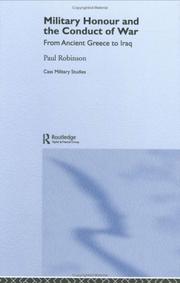| Listing 1 - 10 of 97 | << page >> |
Sort by
|
Book
Year: 2006 Publisher: [Carlisle Barracks, PA] : [Strategic Studies Institute, U.S.Army War College],
Abstract | Keywords | Export | Availability | Bookmark
 Loading...
Loading...Choose an application
- Reference Manager
- EndNote
- RefWorks (Direct export to RefWorks)
Book
Year: 2006 Publisher: [Carlisle Barracks, PA] : [Strategic Studies Institute, U.S.Army War College],
Abstract | Keywords | Export | Availability | Bookmark
 Loading...
Loading...Choose an application
- Reference Manager
- EndNote
- RefWorks (Direct export to RefWorks)

ISBN: 9789004213524 9781905246007 Year: 2006 Publisher: Leiden; Boston : BRILL
Abstract | Keywords | Export | Availability | Bookmark
 Loading...
Loading...Choose an application
- Reference Manager
- EndNote
- RefWorks (Direct export to RefWorks)
For the first time, this study examines in depth how the medieval Japanese masters of Heiho - the Art of War - sought to interpret, illustrate and transmit the principles of China's time-honoured military strategist Sun-Tzu during possibly the most turbulent period of Japanese history, the war-torn Muromachi period (c. 1350 - 1575). In these two centuries a number of gifted warriors, steeped in the teachings of Sun-Tzu and the Chinese Military Classics, developed their own concepts of the arts of warfare, expressed in personal combat, to heights of formidable effectiveness. Rather than consider the weaknesses and strengths of the medieval military command structures, the author focuses instead on certain basic strategies still to be found in the upper levels of these individual masters' teachings, some of which have fortunately survived the five hundred or more years that have elapsed since these strategists passed away. Sun-Tzu's lasting legacy was encapsulated in one simple statement: 'All warfare is based on deception'. This volume, supported by a sixteen-page Plate Section, demonstrates how, and from where, some of these master swordsmen derived their unique understanding of these ancient teachings.
Book
Year: 2006 Publisher: Washington, D.C. : Congressional Budget Office,
Abstract | Keywords | Export | Availability | Bookmark
 Loading...
Loading...Choose an application
- Reference Manager
- EndNote
- RefWorks (Direct export to RefWorks)
Roughly half of the Army's combat forces at the end of 2005 were so-called heavy units-forces that are equipped with armored vehicles and that provide significant firepower. To support those units, the Army maintains a fleet of approximately 28,000 armored vehicles. Now that the Cold War is over, some defense experts have questioned the relevance of such vehicles to the current national security strategy and their continued usefulness (notwithstanding their contributions to recent operations, such as Desert Storm and Iraqi Freedom). The average age of the armored combat vehicle fleet at the end of 2005 was relatively high, and the fleet comprises vehicles designed several decades ago. Moreover, units equipped with the vehicles in the current fleet are too large and too heavy to be moved overseas easily and quickly by the Air Force's C-17s, the most numerous of its long-range transport planes. For all practical purposes, heavy units must be transported overseas by ship-a process that takes weeks. In today's environment of rapidly evolving conflicts, the Army's goal is to have units that have the combat power of heavy units but that can be transported anywhere in the world in a matter of days. To address concerns about the armored vehicle fleet's aging and the difficulties involved in transporting it-as well as to equip the Army more suitably to conduct operations overseas on short notice using forces based in the United States-the service created the Future Combat Systems (FCS) program in 2000. A major modernization effort, the program is designed in part to develop and purchase vehicles to replace those now in the heavy forces; the new vehicles would be much lighter, thereby easing the deployment of units equipped with them. But the FCS program, poised to develop a total of 18 new systems (including eight manned vehicles to replace those in the Army's current armored fleet) and a network to connect them all will not field any new vehicles until December 2014 at the earliest. Furthermore, because those new vehicles will be expensive, the Army plans to buy relatively small quantities of them each year. As a result, the armored vehicles now in the Army's combat units will not all be replaced by FCS components until after 2035, a prospect that has evoked concerns about the costs of maintaining those older vehicles and upgrading them to prevent their becoming obsolete. In addition, questions have been raised about the FCS program's technical feasibility and affordability. Some experts doubt that the Army can develop and test the necessary technologies in time to start producing lightweight manned vehicles by 2012-a requisite for meeting the deadline to field them according to the Army's current schedule. Another concern is funding for the quantities of FCS equipment that the Army is now planning to buy. Any reduction in the FCS procurement rate would force the Army to retain its already aging armored vehicles even longer and to invest more funds in their maintenance.Roughly half of the Army's combat forces at the end of 2005 were so-called heavy units-forces that are equipped with armored vehicles and that provide significant firepower. To support those units, the Army maintains a fleet of approximately 28,000 armored vehicles. Now that the Cold War is over, some defense experts have questioned the relevance of such vehicles to the current national security strategy and their continued usefulness (notwithstanding their contributions to recent operations, such as Desert Storm and Iraqi Freedom). The average age of the armored combat vehicle fleet at the end of 2005 was relatively high, and the fleet comprises vehicles designed several decades ago. Moreover, units equipped with the vehicles in the current fleet are too large and too heavy to be moved overseas easily and quickly by the Air Force's C-17s, the most numerous of its long-range transport planes. For all practical purposes, heavy units must be transported overseas by ship-a process that takes weeks. In today's environment of rapidly evolving conflicts, the Army's goal is to have units that have the combat power of heavy units but that can be transported anywhere in the world in a matter of days. To address concerns about the armored vehicle fleet's aging and the difficulties involved in transporting it-as well as to equip the Army more suitably to conduct operations overseas on short notice using forces based in the United States-the service created the Future Combat Systems (FCS) program in 2000. A major modernization effort, the program is designed in part to develop and purchase vehicles to replace those now in the heavy forces; the new vehicles would be much lighter, thereby easing the deployment of units equipped with them. But the FCS program, poised to develop a total of 18 new systems (including eight manned vehicles to replace those in the Army's current armored fleet) and a network to connect them all will not field any new vehicles until December 2014 at the earliest. Furthermore, because those new vehicles will be expensive, the Army plans to buy relatively small quantities of them each year. As a result, the armored vehicles now in the Army's combat units will not all be replaced by FCS components until after 2035, a prospect that has evoked concerns about the costs of maintaining those older vehicles and upgrading them to prevent their becoming obsolete. In addition, questions have been raised about the FCS program's technical feasibility and affordability. Some experts doubt that the Army can develop and test the necessary technologies in time to start producing lightweight manned vehicles by 2012-a requisite for meeting the deadline to field them according to the Army's current schedule. Another concern is funding for the quantities of FCS equipment that the Army is now planning to buy. Any reduction in the FCS procurement rate would force the Army to retain its already aging armored vehicles even longer and to invest more funds in their maintenance.

ISBN: 9780415392013 0415392012 Year: 2006 Publisher: London: Routledge,
Abstract | Keywords | Export | Availability | Bookmark
 Loading...
Loading...Choose an application
- Reference Manager
- EndNote
- RefWorks (Direct export to RefWorks)

ISBN: 1403987173 9781403987174 Year: 2006 Publisher: Basingstoke Palgrave Macmillan
Abstract | Keywords | Export | Availability | Bookmark
 Loading...
Loading...Choose an application
- Reference Manager
- EndNote
- RefWorks (Direct export to RefWorks)
Information warfare --- Military art and science --- History
Book
Year: 2006 Publisher: Washington, D.C. : Congressional Budget Office,
Abstract | Keywords | Export | Availability | Bookmark
 Loading...
Loading...Choose an application
- Reference Manager
- EndNote
- RefWorks (Direct export to RefWorks)
Roughly half of the Army's combat forces at the end of 2005 were so-called heavy units-forces that are equipped with armored vehicles and that provide significant firepower. To support those units, the Army maintains a fleet of approximately 28,000 armored vehicles. Now that the Cold War is over, some defense experts have questioned the relevance of such vehicles to the current national security strategy and their continued usefulness (notwithstanding their contributions to recent operations, such as Desert Storm and Iraqi Freedom). The average age of the armored combat vehicle fleet at the end of 2005 was relatively high, and the fleet comprises vehicles designed several decades ago. Moreover, units equipped with the vehicles in the current fleet are too large and too heavy to be moved overseas easily and quickly by the Air Force's C-17s, the most numerous of its long-range transport planes. For all practical purposes, heavy units must be transported overseas by ship-a process that takes weeks. In today's environment of rapidly evolving conflicts, the Army's goal is to have units that have the combat power of heavy units but that can be transported anywhere in the world in a matter of days. To address concerns about the armored vehicle fleet's aging and the difficulties involved in transporting it-as well as to equip the Army more suitably to conduct operations overseas on short notice using forces based in the United States-the service created the Future Combat Systems (FCS) program in 2000. A major modernization effort, the program is designed in part to develop and purchase vehicles to replace those now in the heavy forces; the new vehicles would be much lighter, thereby easing the deployment of units equipped with them. But the FCS program, poised to develop a total of 18 new systems (including eight manned vehicles to replace those in the Army's current armored fleet) and a network to connect them all will not field any new vehicles until December 2014 at the earliest. Furthermore, because those new vehicles will be expensive, the Army plans to buy relatively small quantities of them each year. As a result, the armored vehicles now in the Army's combat units will not all be replaced by FCS components until after 2035, a prospect that has evoked concerns about the costs of maintaining those older vehicles and upgrading them to prevent their becoming obsolete. In addition, questions have been raised about the FCS program's technical feasibility and affordability. Some experts doubt that the Army can develop and test the necessary technologies in time to start producing lightweight manned vehicles by 2012-a requisite for meeting the deadline to field them according to the Army's current schedule. Another concern is funding for the quantities of FCS equipment that the Army is now planning to buy. Any reduction in the FCS procurement rate would force the Army to retain its already aging armored vehicles even longer and to invest more funds in their maintenance.Roughly half of the Army's combat forces at the end of 2005 were so-called heavy units-forces that are equipped with armored vehicles and that provide significant firepower. To support those units, the Army maintains a fleet of approximately 28,000 armored vehicles. Now that the Cold War is over, some defense experts have questioned the relevance of such vehicles to the current national security strategy and their continued usefulness (notwithstanding their contributions to recent operations, such as Desert Storm and Iraqi Freedom). The average age of the armored combat vehicle fleet at the end of 2005 was relatively high, and the fleet comprises vehicles designed several decades ago. Moreover, units equipped with the vehicles in the current fleet are too large and too heavy to be moved overseas easily and quickly by the Air Force's C-17s, the most numerous of its long-range transport planes. For all practical purposes, heavy units must be transported overseas by ship-a process that takes weeks. In today's environment of rapidly evolving conflicts, the Army's goal is to have units that have the combat power of heavy units but that can be transported anywhere in the world in a matter of days. To address concerns about the armored vehicle fleet's aging and the difficulties involved in transporting it-as well as to equip the Army more suitably to conduct operations overseas on short notice using forces based in the United States-the service created the Future Combat Systems (FCS) program in 2000. A major modernization effort, the program is designed in part to develop and purchase vehicles to replace those now in the heavy forces; the new vehicles would be much lighter, thereby easing the deployment of units equipped with them. But the FCS program, poised to develop a total of 18 new systems (including eight manned vehicles to replace those in the Army's current armored fleet) and a network to connect them all will not field any new vehicles until December 2014 at the earliest. Furthermore, because those new vehicles will be expensive, the Army plans to buy relatively small quantities of them each year. As a result, the armored vehicles now in the Army's combat units will not all be replaced by FCS components until after 2035, a prospect that has evoked concerns about the costs of maintaining those older vehicles and upgrading them to prevent their becoming obsolete. In addition, questions have been raised about the FCS program's technical feasibility and affordability. Some experts doubt that the Army can develop and test the necessary technologies in time to start producing lightweight manned vehicles by 2012-a requisite for meeting the deadline to field them according to the Army's current schedule. Another concern is funding for the quantities of FCS equipment that the Army is now planning to buy. Any reduction in the FCS procurement rate would force the Army to retain its already aging armored vehicles even longer and to invest more funds in their maintenance.
Book
ISBN: 9571423149 Year: 2006 Publisher: 臺北 三民書局
Abstract | Keywords | Export | Availability | Bookmark
 Loading...
Loading...Choose an application
- Reference Manager
- EndNote
- RefWorks (Direct export to RefWorks)
Book
ISBN: 4409040812 Year: 2006 Publisher: 京都 人文書院
Abstract | Keywords | Export | Availability | Bookmark
 Loading...
Loading...Choose an application
- Reference Manager
- EndNote
- RefWorks (Direct export to RefWorks)
Martial arts --- Martial arts --- Military art and science --- Military art and science --- Philosophy --- Philosophy
Periodical
Year: 2006 Publisher: Dublin [Ireland] : Public Relations Section at the Chief of Staff's Branch
Abstract | Keywords | Export | Availability | Bookmark
 Loading...
Loading...Choose an application
- Reference Manager
- EndNote
- RefWorks (Direct export to RefWorks)
Military art and science --- Military art and science --- History --- Ireland. --- Ireland.
| Listing 1 - 10 of 97 | << page >> |
Sort by
|

 Search
Search Feedback
Feedback About
About Help
Help News
News